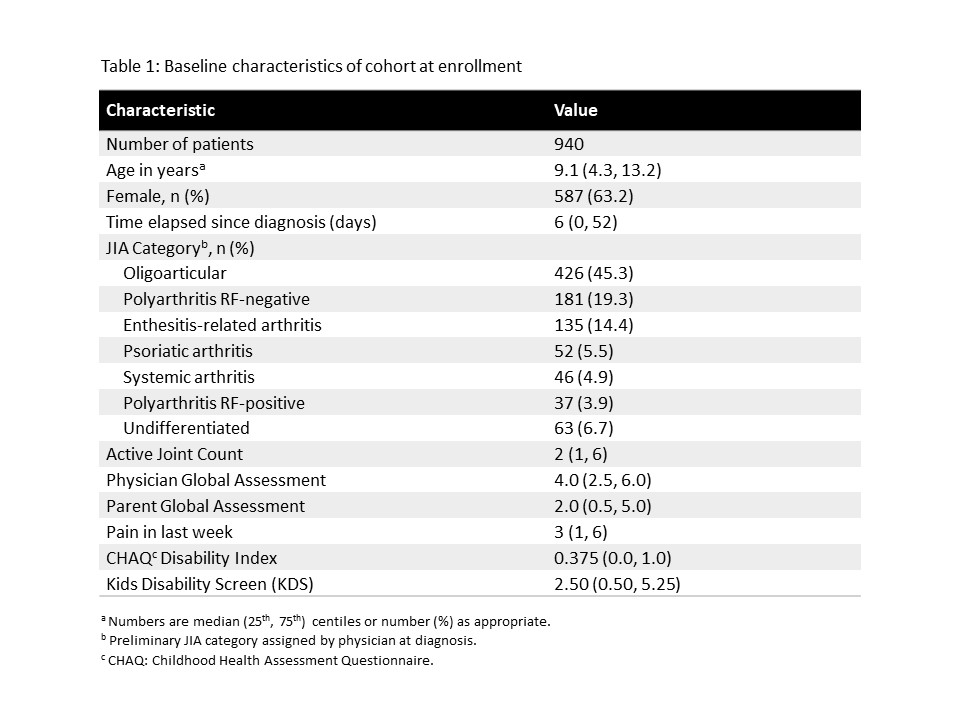Session Information
Session Type: Abstract Session
Session Time: 1:00PM-2:30PM
Background/Purpose: Juvenile idiopathic arthritis (JIA) is the most common chronic rheumatic disease of childhood. Contrary to historical cohorts, it is hoped that with contemporary treatments most children with JIA will quickly improve in physical function. However, little is known about the long-term trajectories of physical function across the seven JIA categories, and the impact of age, sex, and number of active joints. The aim of this study was to describe these trajectories during the first three years following diagnosis and assess factors that may influence them.
Methods: We included children recruited within 3 months of JIA diagnosis in the Canadian Alliance of Pediatric Rheumatology Investigators (CAPRI) Registry whose parents completed at least 2 functional assessments between February 2017 and April 2024. Physical function was assessed using the Kids Disability Screen (KDS); the mean of numerical answers to 2 questions: “Does your child usually need help from you or another person because of arthritis?” and “Is it hard for your child to run and play because of arthritis?” This screen is scored from 0=no disability to 10=severe disability and has been shown to be comparable to a full Childhood Health Assessment Questionnaire (CHAQ) disability index1. Data was analyzed with descriptive statistics and mean trajectories were charted using LOWESS estimated with a bandwidth of 0.8.
Results: Out of a total of 1,137 children recruited within 3 months of diagnosis in the registry, 940 patients (82.6%) provided at least 2 physical function assessments for a total of 7,351 assessments, 6,088 of which occurred within 3 years of diagnosis. Most children had oligoarthritis (n=426, 45.3%), polyarthritis RF-negative (n=181, 19.3%) or enthesitis-related arthritis (ERA) (n=135, 14.4%). The median age at diagnosis was 9.1 years (IQR 4.3, 13.2) and 587 (63.2%) were female (Table 1). Trajectories varied across JIA categories. Polyarthritis RF-positive had the highest mean KDS score upon diagnosis, and psoriatic arthritis had the lowest. LOWESS indicated that KDS scores improved for all categories over time (Figure 1). At 3 years follow up, children with ERA and systemic JIA seemed to have higher mean KDS scores than the other categories. Although all trajectories showed improvement over time, no category reached a mean of 0, and some individuals in each category still had KDS scores >4 within the 3rd year (Figure 2). Higher active joint counts at diagnosis and female sex appeared to be associated with higher mean KDS scores until weeks 80 and 140 respectively. Age at diagnosis did not appear to have a consistent relationship with mean KDS scores.
Conclusion: JIA categories that start at different levels of functional impairment all show improvement over time, but a subset of children continue to report functional deficits well into their disease course. On average, females, and patients with higher active joint count at baseline report higher levels of disability. Further identification of the population experiencing persisting functional deficits will be important to improve the overall outcomes of JIA.
Funded by The Arthritis Society and The Canadian Institute of Health Research.
1 Houghton K, et al. Rheumatology. 2022;61(12):4835–44.
To cite this abstract in AMA style:
Cunningham C, Berard R, Berkowitz M, Feldman B, Johnson N, Lim L, Loughin T, McPherson M, Miettunen P, Proulx-Gauthier J, Rumsey D, Schmeling H, Tucker L, Houghton K, Guzman J. Trajectories of Physical Function in Children with Juvenile Idiopathic Arthritis: Results from the CAPRI Registry [abstract]. Arthritis Rheumatol. 2024; 76 (suppl 9). https://acrabstracts.org/abstract/trajectories-of-physical-function-in-children-with-juvenile-idiopathic-arthritis-results-from-the-capri-registry/. Accessed .« Back to ACR Convergence 2024
ACR Meeting Abstracts - https://acrabstracts.org/abstract/trajectories-of-physical-function-in-children-with-juvenile-idiopathic-arthritis-results-from-the-capri-registry/



